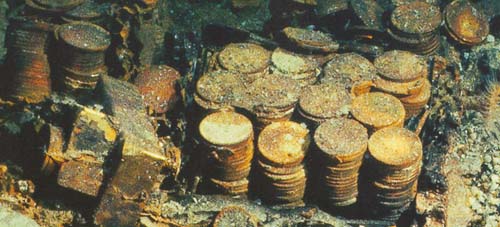Archive
Searching (again!?) for the SS Central America

On Tuesday, September 8th 1857, the steamboat SS Central America left Havana at 9 AM for New York, carrying about 600 passengers and crew members. Inside of this vessel, there was stowed a very precious cargo: a set of manuscripts by John James Audubon, and three tons of gold bars and coins. The manuscripts documented an expedition through the yet uncharted southwestern United States and California, and contained 200 sketches and paintings of its wildlife. The gold, fruit of many years of prospecting and mining during the California Gold Rush, was meant to start anew the lives of many of the passengers aboard.
On the 9th, the vessel ran into a storm which developed into a hurricane. The steamboat endured four hard days at sea, and by Saturday morning the ship was doomed. The captain arranged to have women and children taken off to the brig Marine, which offered them assistance at about noon. In spite of the efforts of the remaining crew and passengers to save the ship, the inevitable happened at about 8 PM that same day. The wreck claimed the lives of 425 men, and carried the valuable cargo to the bottom of the sea.
It was not until late 1980s that technology allowed recovery of shipwrecks at deep sea. But no technology would be of any help without an accurate location of the site. In the following paragraphs we would like to illustrate the power of the scipy stack by performing a simple simulation, that ultimately creates a dataset of possible locations for the wreck of the SS Central America, and mines the data to attempt to pinpoint the most probable target.
We simulate several possible paths of the steamboat (say 10,000 randomly generated possibilities), between 7:00 AM on Saturday, and 13 hours later, at 8:00 pm on Sunday. At 7:00 AM on that Saturday the ship’s captain, William Herndon, took a celestial fix and verbally relayed the position to the schooner El Dorado. The fix was 31º25′ North, 77º10′ West. Because the ship was not operative at that point—no engine, no sails—, for the next thirteen hours its course was solely subjected to the effect of ocean current and winds. With enough information, it is possible to model the drift and leeway on different possible paths.
Seked

If a pyramid is 250 cubits high and the side of its base 360 cubits long, what is its seked?
Take half of 360; it makes 180. Multiply 250 so as to get 180; it makes
of a cubit. A cubit is 7 palms. Multiply 7 by
The seked is
palms [that is,
].
A’h-mose. The Rhind Papyrus. 33 AD
The image above presents one of the problems included in the Rhind Papyrus, written by the scribe Ahmes (A’h-mose) circa 33 AD. This is a description of all the hieroglyphs, as translated by August Eisenlohr:

The question for the reader, after going carefully over the English translation is: What does seked mean?
Nezumi San

On January first, a pair of mice appeared in a house and bore six male mice and six female mice. At the end of January there are fourteen mice: seven male and seven female.
On the first of February, each of the seven pairs bore six male and six female mice, so that at the end of February there are ninety-eight mice in forty-nine pairs. From then on, each pair of mice bore six more pairs every month.
- Find the number of mice at the end of December.
- Assume that the length of each mouse is 4 sun. If all the mice line up, each biting the tail of the one in front, find the total length of mice
Jinkō-ki, 1715
Ruthless Thieves Stealing a Roll of Cloth

Some thieves stole a long roll of silk cloth from a warehouse. In a bush far from the warehouse, they counted the length of the cloth. If each thief gets 6 hiki, then 6 hiki is left over, but if each thief takes 7 hiki then the last thief gets no cloth at all. Find the number of thieves and the length of the cloth.
Jinkō-ki, 1643



